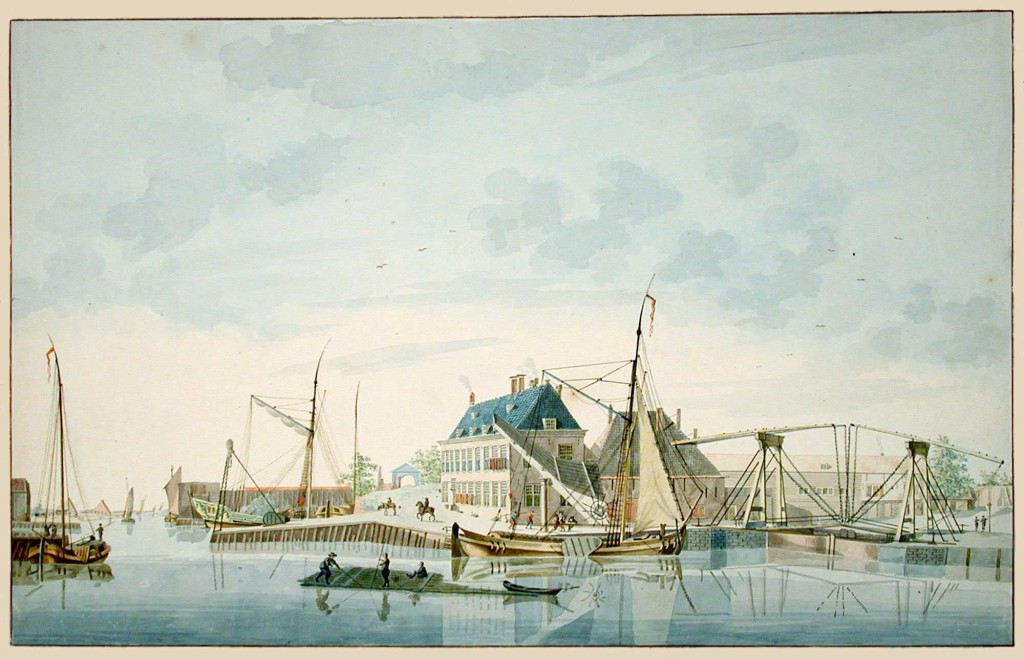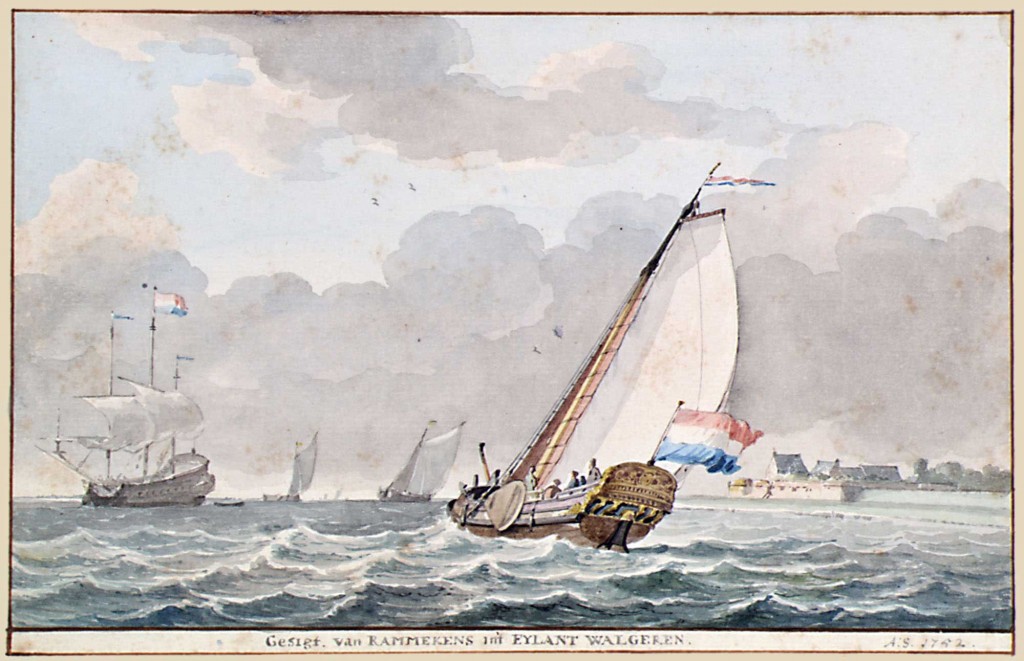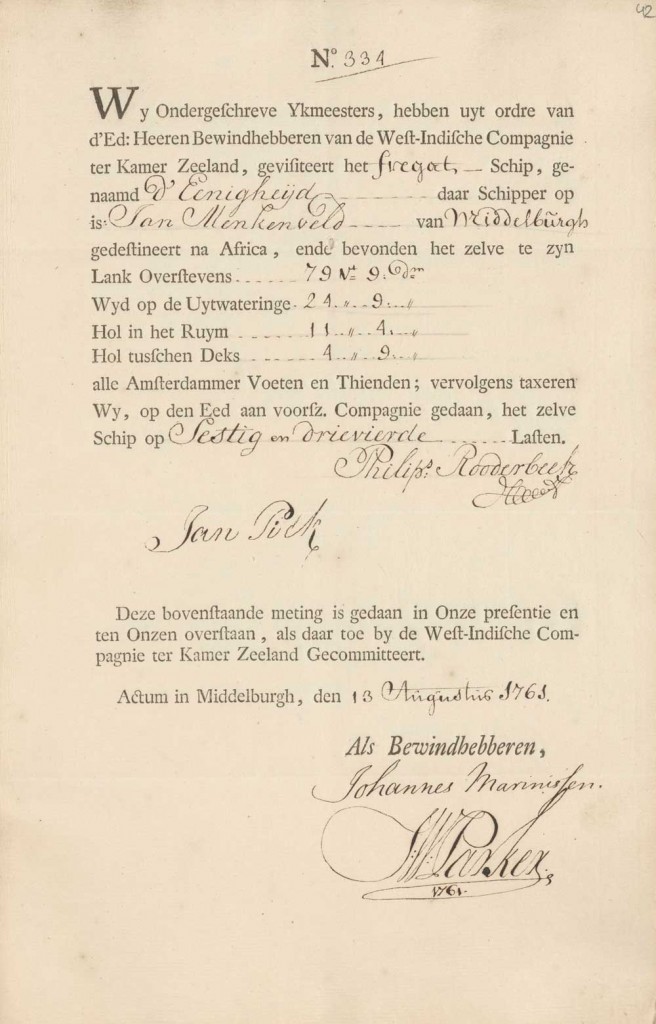Before the ship the Unity could depart, it had to be loaded and brought to the Western Scheldt at Flushing, the Netherlands.
Departure from Middelburg
Before departure the MCC paid so called city harbor taxes (taxes for loading or unloading a ship) to Middelburg. The account mentiones a cargo of 45 loads and 10 canons, the sea and water rights and common docking taxes.
On 2 September 1761 the ship was ‘set out’. It left the harbor of Middelburg via the Slijk arch, also called Zuiddam arch. The ship was brought to fort Rammekens at the Western Scheldt via the Channal of Welsinge, the water between Walcheren and St. Joosland. this happened under supervision of a pilot from Middelburg. He used four couples of horses to pull the Unity. On the account the pilot mentioned that the ship had a depth of 13 feet, so 3.90 meters – according to the feet of Middelburg of 0.3 meters.
Onto the Western Scheldt
The ship was then brought onto the Western Scheldt. This meant that in a few hours time the ship was brought onto the roadstead of Rammekens. Fort Rammekens is a bastion or coast fort of the 16th century located on the most south eastern point of Walcheren. The ship the Unity was brought to the roadstead of Rammekens a couple of days after 18 September. The crew was expected to help out without receiving any reward, their wage only started after leaving the Western Scheldt. The crew was mustered up by drumrolls, which happened on 18 September in both Middelburg and Flushing.
Porters
From the end of August until a couple of days before departure the ship was being loaded. This happened in the harbor of Middelburg, at fort Rammekens and on the roadstead of Rammekens. The shipment – cargason, food, ship’s chests, etc. – were carried to the ship. The account with the wages of the porters has been preserved. During the first two weeks three members of the crew were amongst the porters: boatswain Pieter Pieterssen, boatwain’s mate and sail maker Hans Kraamer and sailor Roelof Siebers worked for approximately three to five days. Hans Kraamer worked for another 8 days during the last weeks. On Wednesday 30 September the last order was received on board: bread.
Seeing off
Wednesday 30 September a group consisting of the ‘lords of the equipage’ and the ‘lords of commerce’ of the MCC came on board for a visit. They arrived with the yacht of the MCC which was provided with food for the occasion. The lord inspected the ship the Unity and gave official permission for departure. The captain received the travel documents and signed them together with the first mate. They also both signed the instructions to the captain, the ship’s inventory and the cargo list.
After the pilot came on board the voyage could begin. The 3rd voyage of the ship the Unity was ready to start after less than three months of preparation. The organization in several dates:
- 7 July 1761: the ship the Unity returns from a voyage to Curaçao
- 14 July: captain Jan Menkenveld commissioned as captain on the next ship’s voyage, with the assignment to form a concept cargason. (Menkenveld had returned from a voyage with the MCC ship the Philadelphia to Suriname on 9 July)
- 21 July: the board of the MCC decides to prepare the ship the Unity as quickly as possible for a voyage to the coast of Guinea for ‘the purchase of slaves’, commission of captain and officers
- 13 August: the ship is measured by the WIC (The West India Compagny)
- 30 August: the porters begin loading the ship, till 26 September
- 1 September: decision to drum in Flushing and Middelburg, insurance of the ship and finishing of loading
- 2 September: the ship the Unity is ‘set out’
- 5 September: drumming up of the remaining members of the crew in Flushing and Middelburg, including the announcement of the muster on 7 September
- 7 September: muster of the entire crew
- 15 September: adjustment of the insurance of the ship and the cargo
- 18 September: drumming up of the crew in Middelburg en Flushing for bringing the ship onto the Western Scheldt
- 26 September: the porters have finished loading the ship
- 29 September: the ship lies ready at the roadstead of Rammekens, decision to see captain Menkenveld off on 30 September, the captain is informed of this by the lords of the equipage
- 30 September: the lords of the equipage and the lords of commerce visit the ship ‘and finding the state on board respectable, saw if off’
- 1 October: departure from the roadstead of Rammekens
Sources:
- Sijnke, P.W., Uit de Middelburgse Historie (Middelburg)
- Unger, W.S., ‘Bijdragen tot de geschiedenis van de Nederlandse slavenhandel. II: De slavenhandel der Middelburgsche Commercie Compagnie, 1732-1808′, in: Economisch-Historisch Jaarboek. Bijdragen tot de economische geschiedenis van Nederland 28 (1958-1960)

Harbor of Middelburg
To the right the master of equipage’s house of the Dutch East India Company and the Dokbridge. Drawing, anonymous and undated, 36.2×56 cm. Zeeland Archives, Zelandia Illustrata II, inv.nr 290.

Fort Rammekens, 1752
Fort Rammekenson the Island Walcheren in Zeeland. Aart Schouman (1710-1792, drawing, 1752, 15×23.4cm. Zeeland Archives, Zelandia Illustrata II, inv.nr 904.

Certificate of measurement
Certificate of measurement of the ship The Unity, 13 August 1761. Zeeland Archives, Archives of the MCC, inv.nr 148.

